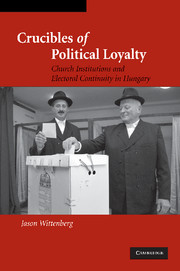Book contents
- Frontmatter
- Contents
- List of Figures
- List of Tables
- Acknowledgments
- INTRODUCTION
- 1 EXPLAINING POLITICAL PERSISTENCE
- 2 ELECTORAL PERSISTENCE AND VOLATILITY IN HUNGARY
- 3 THE CHURCHES FIRST CONFRONT COMMUNISM
- 4 THE BATTLE FOR SOULS, 1948–1956
- 5 THE BATTLE FOR SOULS AFTER 1956
- 6 CHURCH COMMUNITY AND RIGHTIST PERSISTENCE: STATISTICAL EVIDENCE
- 7 CONCLUSION
- Appendices
- Bibliography
- Index
- Titles in the series
4 - THE BATTLE FOR SOULS, 1948–1956
Published online by Cambridge University Press: 02 September 2009
- Frontmatter
- Contents
- List of Figures
- List of Tables
- Acknowledgments
- INTRODUCTION
- 1 EXPLAINING POLITICAL PERSISTENCE
- 2 ELECTORAL PERSISTENCE AND VOLATILITY IN HUNGARY
- 3 THE CHURCHES FIRST CONFRONT COMMUNISM
- 4 THE BATTLE FOR SOULS, 1948–1956
- 5 THE BATTLE FOR SOULS AFTER 1956
- 6 CHURCH COMMUNITY AND RIGHTIST PERSISTENCE: STATISTICAL EVIDENCE
- 7 CONCLUSION
- Appendices
- Bibliography
- Index
- Titles in the series
Summary
Introduction
This chapter chronicles the opening skirmishes in the battle for mass loyalties between the Party and the Churches. During Hungary's Stalinist period the Party sought not merely to enforce outward compliance with the rules and rituals of communist life, but also to rid society of beliefs that contradicted the socialist values it hoped to instill. As we saw in Chapter 3, it went to great lengths to remove the Churches from the privileged position they had held in Hungarian society, and to fill their leadership positions with those sympathetic to socialism. Nonetheless, with churches in nearly every village to serve the faithful, the Churches remained the single largest impediment to the creation of a “new socialist man.” For the Party to succeed they would have to be conquered from below as well as from above.
I devote a great deal of space, in this chapter and Chapter 5, to narrating the often ingenious ways in which the clergy attempted to foster church community. These clerical strategies can be read in two ways. First, in theoretical terms they represent efforts to manipulate how the population perceived the risks and rewards of public religious practice. As discussed in prior chapters, the clergy's goal was to maximize the reward and minimize the risk; the cadres attempted to minimize the reward and maximize the risk. Both the clergy and the cadres hoped that their respective actions would signal others as to the “correct” behavior.
- Type
- Chapter
- Information
- Crucibles of Political LoyaltyChurch Institutions and Electoral Continuity in Hungary, pp. 114 - 151Publisher: Cambridge University PressPrint publication year: 2006



